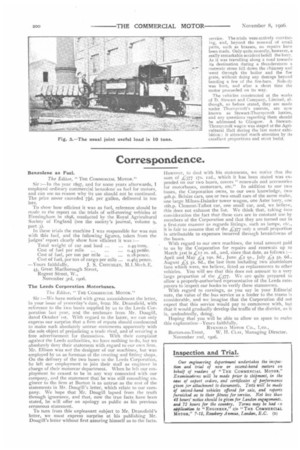Thornycroft Wagons in France.
Page 17

Page 18

If you've noticed an error in this article please click here to report it so we can fix it.
Typical Vehicles Employed by a Brewer, a Coal Merchant," and a Miller.
c are able to give illustrations, this week, of three of the numerous Thornycroft steam wagons now working in France. These are of the same type, viz., the 6-ton model, capab:e of carrying six tons on the platform, with a further load of two tons upon a trailer. The system of transmission in these vehicles is so well known that it is unnecessary to give a description of it in this article. Thornycroft wagons have been built in France under license, whilst the agency has been successfully conducted by Messrs. Henry Johnson and Sons, of Paris, for abut t three years. Owing to the expansion o: the motorbus and pleasure-car brauche, of the business, John I. Thornycroft and Company, Limit2d, whose motor works are at Basingstoke and Chiswick, found it necessary, about a year ago, to appoint a firm to undertake the construction of its steam lorries. D. Stewart and Company tzi, Limited, of London Road ironworks, Glasgow, was made the sole licensee for the production of these vehicles under the Thornycroft patents for Great Britain, and since that period all wagons of this type have been made in that company's workshops at the abovementioned address. The arrangement has proved eminently satisfactory, insomuch as the Chiswick company has been able materially to increase its plant for the manufacture of mototbus chassis, which was impracticable previously.
The wagon shown in Fig. 1 has recently been purchased by Karcher et who own one of the largest breweries in Paris. Previous to its being bought trials were made for a period extending over one month, and its performance has so conclusively proved the capabilities of the lorry that, in all probability, further orders will result. The vehicle is used for the transporting of beer from the brewery to the different customers, and has proved itself, although in use only a comparatively short time, to be much superior to the old-fashioned horse-drawn drays which were formerly employed.
The vehicle shown in Fig. 2 is a 6-ton
lorry, fitted with a tipping body, owned by Mons. Henry Chupin, the proprietor of a large glassworks near Fougeres. The vehicle is used principally for the conveyance of coal from the railway station to the works, a distance of, approximately, 3 kilometres. The load is generally about 6 tons. The road is a good one, with the exception of a hill of 1 in 14, and, of course, the usual pavi is met with in the town itself. This wagon was delivered to Mons. Chupin in September, 1904, and
it speaks well both for the design and workmanship of the lorry that only unskilled labourers have been employed to look after it and to drive it. Naturally, the upkeep was excessive, as is generally the case when men not properly qualified are allowed to drive any type of self propelled motor vehicle. An English driver has recently been obtained for this lorry, and the results have been very much better than heretofore, the repair bill having been much decreased. Fig. 3 shows a 0-ton wagon, with a trailer attached, which has been doing constant and hard work ever since September, 1903. it was purchased in that year by Messrs. Vilgrains Simon et Cie., of Le Grand Moulin de Nancy, who own large flour mills in that town. The district is a hilly one, and the vehicle has to work in all weathers ; a trailer is
used when the state of the road permits. The average load carried is 6 tons on the platform, and, when .in use, an additional 4 tons upon the trailer. Although the total load is a heavy one, the wagon has been run consistently for five days a week since the time of its purchase. The sixth day is devoted generally to overhauls of the machinery, the packing of glands, and a thorough washing-out of the boiler. The average distance covered is about 40 miles per day, but longer journeys have occasionally to be made. This wagon is fitted with cast-steel wheels, which have proved most satisfactory in every respect. Our Paris correspondent says that it would be impossible for wooden wheels to stand up to the severe working conditions under which they would have to run. Previous to the purchase of this vehicle the buyers stipulated that it should make a trial extending over three months, and do precisely the same work as it would have to do as ordinary routine service. The trials were entirely convincing, and, beyond, the renewal of small parts, such as brasses, no repairs have been made. Only quite recently, however, a really remarkable accident befell the lorry. As it was travelling along a road towards its destination during a thunderstorm a meteoric stone fell down the chimney and went through the boiler and the fire grate, without doing any damage beyond bending a few of the fire-bars. Nobody was hurt, and after a short time the motor proceeded on its way.
The vehicles constructed at the works of D. Stewart and Company, Limited, although, as before stated, they are made under Thornycroft's patents, are now known as Stewart-Thornycroft lorries, and any questions regarding them should be addressed to Glasgow. A StewartThornycroft wagon was staged at the Agricultural Hall during the last motor exhibition; it attracted much attention by its excellent proportions and stout build.
























